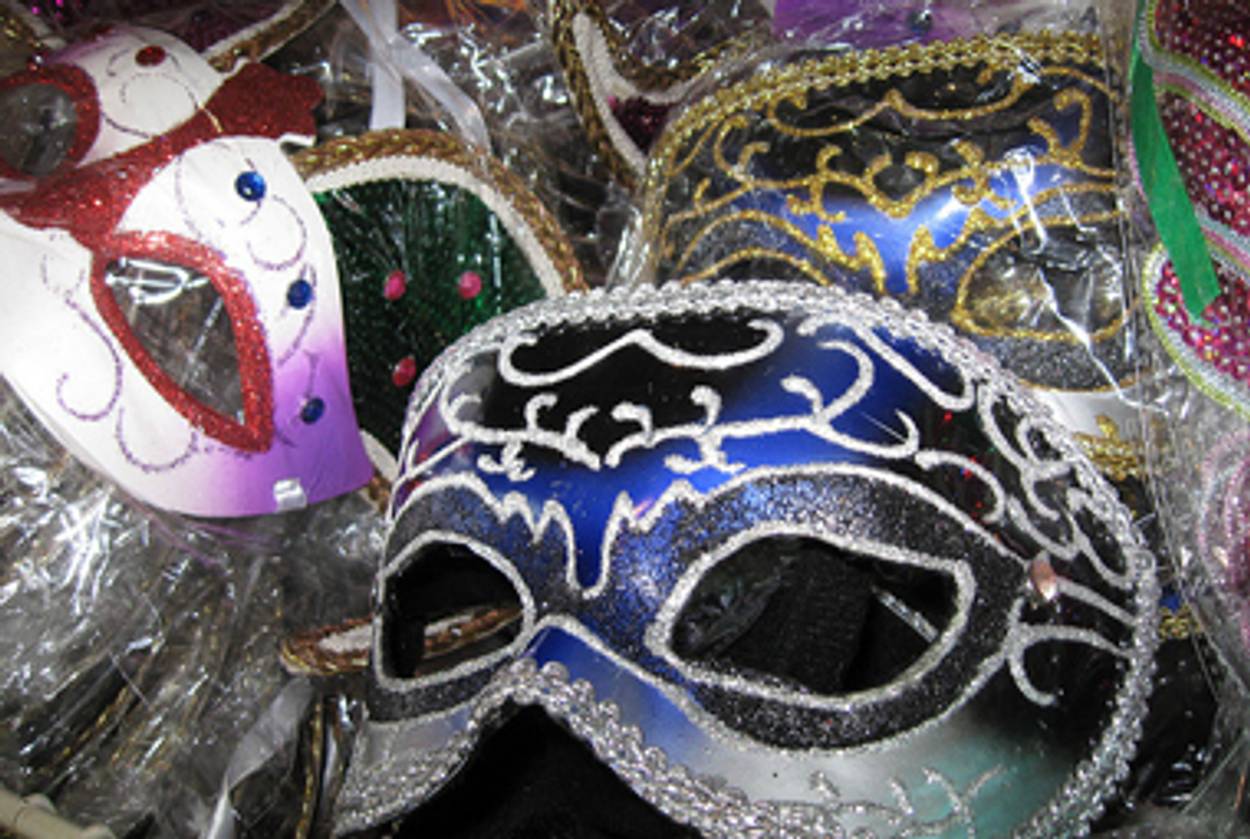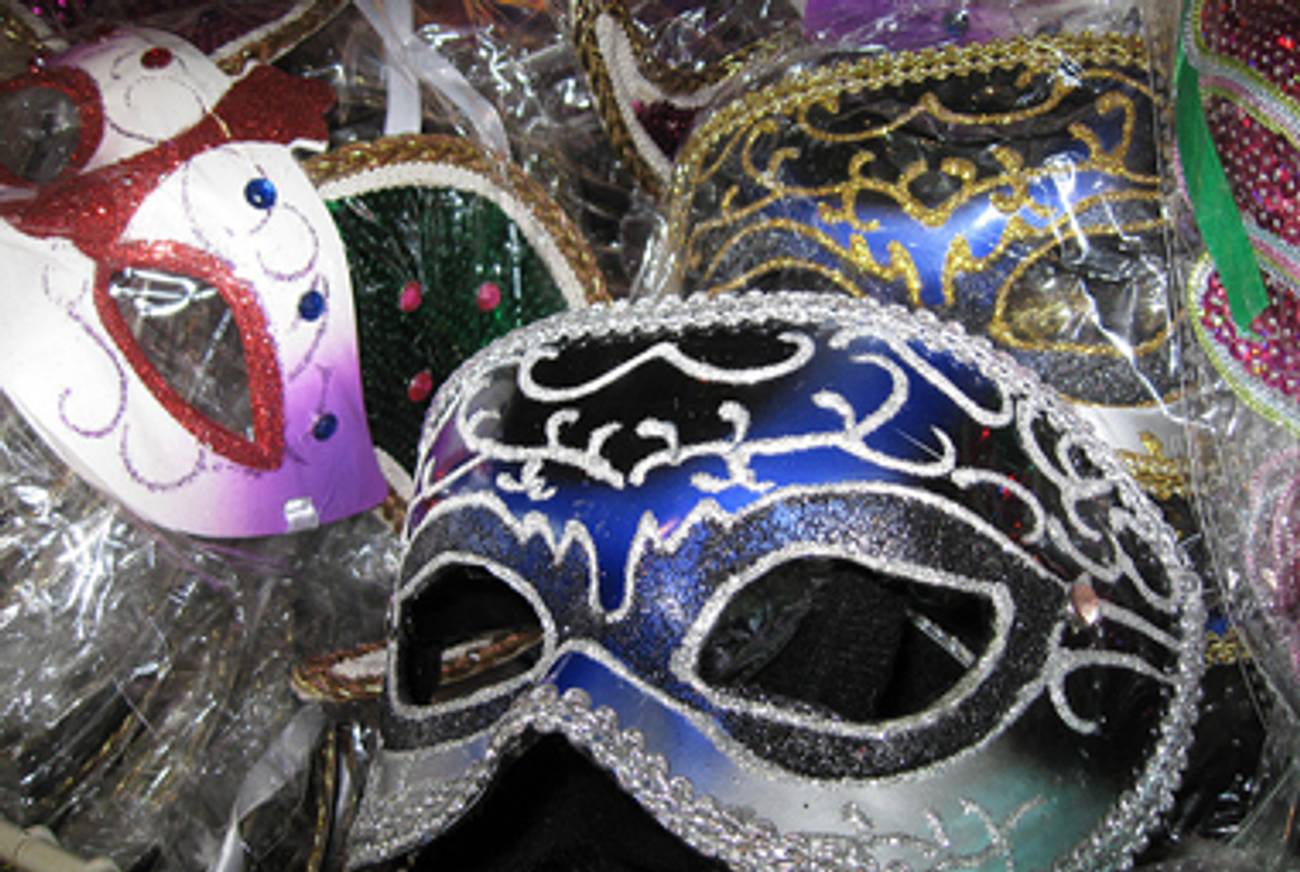Dressed Up
With Purim approaching and a costume in order, seeking sartorial inspiration from the Book of Esther, European paintings, Elizabeth Taylor, and several style gurus, one of whom recommends an edible hat




For Purim this year, which arrives on Saturday night, I wanted a costume inspired by the events and characters of the story itself.
But there’s not much textual guidance. The Book of Esther opens with a description of a feast. It tells of white cotton and royal-blue wool wall hangings embroidered with cords of fine linen and purple wool, suspended over silver rods and marble pillars. There are gold and silver couches on platforms of green, white, shell, and onyx marble. When Queen Vashti, King Ahasuerus’ first wife, refuses to come to the banquet when summoned, Ahasuerus banishes her. After that, the Purim story is all plot, no scenery. With the exception of the royal finery that Mordecai, Esther’s uncle, will don for his parade—a line about blue and purple robes and a large gold crown—there is no visual information to go on.
Looking for inspiration, I rang Susan Handler, co-owner of Manhattan’s Creative Costume, which rents costumes for theater and film and to the general public. “No, we don’t really have Purim,” Handler said. “Nobody asks for Purim. People come in for Purim and want in general what everybody wants.” What in general do people want? “Today I just did a Purim couple: a mermaid and king Neptune.” Frankie Steinz, the owner of the eponymous costume shop in Manhattan, concurred: “Nobody wants Purim—we do things like fruit bowls and refrigerators and movie stars,” she said, adding that typically Purim is a time for theme parties, just not 6th-century-BCE Shushan-theme parties.
I thought I’d turn to movies, but it turns out unless you want be a Raoul Walsh-ian Middle-Eastern siren (such as Joan Collins in Esther and the King or Elizabeth Taylor in Cleopatra), there’s not much to go with.
Finally, I looked to fine art and hit the jackpot. Painters have depicted nearly every scene of the Purim tale. Not only does Western art offer interpretations of Shushan garb from 1650s through the 1890s, but many of the looks are easy to approximate from stuff you could grab from your or your grandmother’s closet. Ernest Normand’s portrait Vashti Deposed, from the late 19th century, reveals the banished queen wrapped in an indigo robe, her black hair falling over her face, lying in a commodious bed. It’s an affecting look—and easy to replicate. For the more risqué, there’s a blonde Esther in Theodore Chasseriau’s La Toilette d’Esther, from 1841, in which our heroine is naked but for a piece of white fabric draped across her waist, a gold necklace, and bangles.
The Purim scene that garnered the most painterly attention is Esther appearing before king Ahasuerus. Poussin’s Esther Before Assuerus (1640), Batoni’s Esther Before Ahasuerus (1740), and Lefevre’s Esther Before Ahasuerus (1675) each contain solid blocks of colorful cloaks, which my eye gravitated toward. Sir John Everett Millais’ 19th-century Esther is a magnificent portrait of a red-haired queen in contemplation, wearing a loose canary-yellow robe with splotches of color. (Millais used an authentic Chinese Qing-dynasty robe turned inside-out for Esther’s gown, I discovered: There’s a great idea.) I made my decision: I would try my hand at just such a Purim cloak, a simple no-sew affair.
I called Mood Fabrics, of Project Runway fame, located in New York’s Garment District. The clerk assured me that making a cloak and dyeing it to my specifications would be easy. “Dyes work best on natural fibers like cotton or silk or wool,” she explained. “Your best bet would be cotton, but for more weight go for wool.” An adult-sized cloak requires 4 to 5 yards of fabric, one for a small child, 2 to 3.
On the Rit dye website I found a neat color chart that indicates precise color recipes. Esther’s robe by Millais? That would be Yellow 2 #61: “1/4 Tsp Rose Pink, 1 Tbs Lemon Yellow and 1 Cup water.” Batoni’s pink and pea-green Ahasuerus is a cinch to match, as are Poussin’s courtiers in blazing orange and cobalt blue.
It seemed so easy, I wanted to do more. And what about crowns and accessories? I called Ellen Christine Colon-Lugo, a New York milliner whose confections are sold at Bendel’s and the shop of Metropolitan Opera and have appeared in publications like Elle and Vogue. She suggested investing in a turban. “They are in right now, and it’s a good excuse to buy one,” she said. “You can stick feathers in a turban, or pin on broaches.” She suggested visiting a South Asian emporium for a costume. “Indian shirts, the embroidered or mirrored ones, the cotton ones with shiny dots are a good choice, and Sari fabric is also great.”
Jessica Harris, a buyer at the Wasteland, a popular vintage shop on Los Angeles’ Melrose Avenue, suggested keeping it simple. “You can buy some fabric and add jewels,” she said. “Tie a bunch of different scarves together to make a cape or stoles and visit a crafts store—there are tons of ideas there for fabric decorations.”
Sandy Schreier, a private collector of haute couture and Hollywood costumes (she owns Rita Hayworth’s gown from Gilda), hesitated to offer Purim costume advice—at first. “I am not a Purim dresser,” she said. “It’s hard for me to dress up because of what I do and what I’m known for—it has to be all or nothing.”
She recalled that the last time she attended a Purim party, she and her husband dressed as Esther and Haman, and they “made the costumes as if they were at Sunday Hebrew school.” She glued feathers on her nightgown and made tin-foil crowns. She encouraged aggressively homemade-looking confections—Sunday School chic. “Everyone’s got cardboard and tin foil, so start with that,” Schreier said. “Make a crown and glue glitter on it. Take various dollar-store beads like for Mardi Gras, or better, your mother’s or grandmother’s costume jewelry, and pile it on.”
Once she got going she couldn’t be stopped: “Take that old bridesmaid’s dress or prom dress and put that on as a base—or the nightgown, a great fallback. Go to a sewing store or fabric shop and buy some of that silver or gold crinkled fabric and make a train from your shoulders, fastening the fabric with a broach around your neck. I would also wear a wig—actually two or three piled on top like Elizabeth Taylor in Cleopatra.” For footwear, don sandals. “This is the season for gladiators,” she said.
As for men, Schreier thought that evil Haman would be the most fun to dress. She suggested using a bathrobe and making a three-cornered hat out of cardboard and brown felt and then adding small hamantashen. “You can shellac them,” she said, “or better yet, don’t. Let people pick and eat from the hat, an edible hat, and put a sign on his back ‘Haman likes to share’.”
I liked this idea of incorporating edible elements. I might try lining my Millais-inspired robe with hamantashen.
Erika Kawalek is a New York-based writer. Her first book, Ragpicker, will be published in 2012 by Riverhead Books.
Erika Kawalek is a New York-based writer. Her first book, Ragpicker, will be published in 2012 by Riverhead Books.